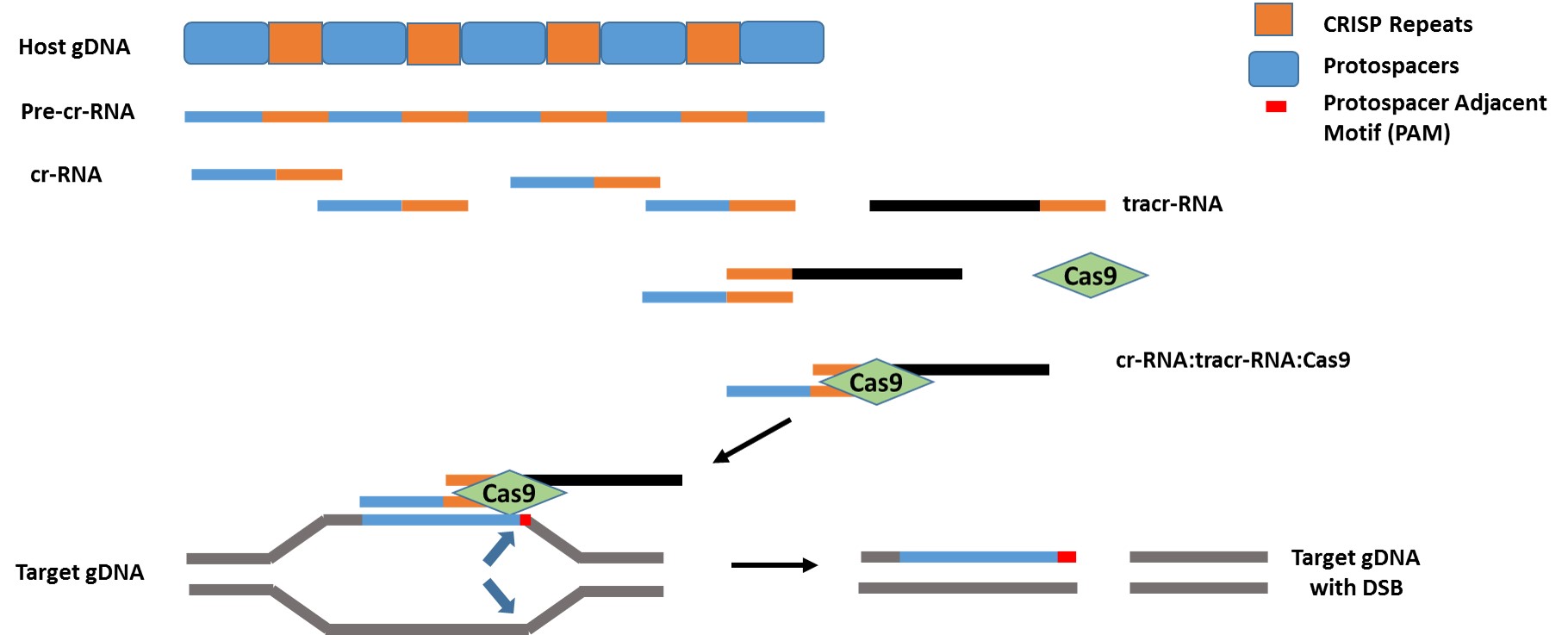The remarkable discovery of DNA double helix model and gradual refinements in scientific knowledge gained by the decades of research have not only provided a deeper insight into the intricacies of life but also have made it amenable to many breakthrough technologies.
A recent addition to this repertoire of technologies is Genome Editing. Genome editing broadly refers to all those technologies wherein site specific DSBs (Double stranded breaks) are introduced in the genome of a cell or an organism and these breaks are repaired by either Non-homologous end joining (NHEJ) or Homology directed repair (HDR) leading to insertions, deletions or specific replacement of the target gene sequence.Until lately three major genome editing technologies were known i.e., ZFNs (Zinc Finger Nucleases), Meganucleases and TALENs (Transcription Activator-Like Effector Nucleases). However, these earlier approaches had their own snags like beingprotein-based systems these are very expensive and difficult to customize and synthesizeand alsorequire very high endexpertise and experimental setups. Interestingly, the year 2013 saw the advent of an extraordinarily facile genome engineering method based on bacterial CRISPR/Cas9(CRISPR- Clustered Regulated Insterspaced, Short Palindromic Repeat ; Cas9 – CRISPR associated protein 9) system and as a result genome engineering is now at commonplace andfield of biological research is experiencing a transformative phase.Here in this article we havefocused on the fundamentals of CRISPR/Cas9 technology its relevance in biological research and its future outlook.
CRISPR/Cas9 system – An Introduction
CRISPR/Cas9 system was identified in bacterial systemas a mechanism of adaptive immune response against the invaders like viruses and bacteriophages. As adefense mechanism the DNA of the invading organism is incorporated into tandem array of CRISPR repeats present in the bacterial genome. After this merger the complete region is then transcribed by the RNA polymerases.The emanating transcripts are eventually processed into mature "cr-RNA" (CRISPR RNA) (Figure 1). Each mature crRNA consists of a transcribed sequence from the invading DNA, known as "protospacer" sequence and a part of the CRISPR repeats. A Second class of RNA known as transactivating CRISPR RNA (tracr RNA) forms hybrid with each crRNA and eventually forms a complex with Cas9 nuclease. This CRISPR/Cas9 complex is directed to the protospacer complementary sequence in the foreign DNA wherein Cas9 performs the cleavage of the target sequence (Figure1).
CRISPR/Cas 9 – A tool forgenome engineering
With the discovery of bacterial CRISPR/Cas9 system researchers are now exploring the enormous potential of this technology in site specific genome editing. Of all the identified CRISPR/Cas9 systems, Type II CRISPR/Cas9 system of S. pyogenes is well characterized and has been engineered to perform site specific genome modification(s) in a variety of organisms. To perform site specific editing in vivotwo basic components have to be introduced into the target organism (a) a guide RNA to recognize the target and, (b) a Cas9 nuclease. Guide RNA is made up by fusion of crRNA and tracrRNA (Figure 2). The 20 nucleotides at the 5' end which corresponds to the protospacer sequence of crRNA directs the Cas9 nuclease to the target site which is complementary to the protospacer sequence (Figure 2). Thus with this system, by altering the protospacer sequence of crRNA, the Cas9 nuclease can be virtually directed to cleave any target site.These induced site specific double stranded breaks (DSBs) are further repaired either by the cell endogenous NHEJ method which is present in all cells or by HDR in which Homologous recombination takes place between the externally introduced DNA sequence and the DNA at the DSB site.

Figure 2
Advantages
CRISPR/Cas9 being a simple and versatile technology offers several advantages over the other genome editing tools. One of the major advantage of CRISPR/Cas9 is that it obviates the need of protein engineering which is a challenging task as in case of other genome editing tools. Testing and designing of gRNA is straightforward and simpler than engineering a protein(s) for a specific target site. Moreover, by fiddling with only 20nucleotide of gRNA a huge library of gRNA's can be generated which can be used for high-throughput functional genomics applications. Also, CRISPR/Cas9 is highly suitable for multiplexing. Practically along with a monomeric Cas9 any number of gRNAs, having varied specificities, can be introduced into a cell to cleave multiple target sites. Finally, being a cost effective technology CRISPR/Cas9 will prove to have a wide reach even to research groupsin developing countrieshaving limited research budgets. Taken together, all theseadvantages have made this cutting edge technology a mainstream method across the research laboratories workingin the areas of genome editing.
Limitations
Though CRISPR/Cas9 is deemed as a breakthrough technology it do has some inherent constraints. The most potent problem with CRISPR/Cas9 is the 'off target effect.' Mutation can be induced by a gRNA at sites similar, but not identical, to the target site. These off targets are difficult to identify and the only way possible would be a genome wide survey for the sites showing sequence similarity to the target site. Nevertheless, efforts are being directed to rectify the problem of 'off target' pertaining to the successful application of this technology in near future.
Applications& Future Perspectives
In the past two years CRISPR/Cas9 technology has emerged as a groundbreaking technology laced with all desirable qualities like simplicity, amenability and affordability. Although the full potential of CRISPR/Cas9 is yet to be realized it is anticipated to revolutionize the way biological research is conducted.For instance recently researchers at Cambridge University have demonstrated the use of CRISPR/Cas9 in fixing a genetic disorder, Tyrosinaemia, in adult animals thus reinforcing the use of this technology in designing novel strategies for human therapeutics. Similarly, crop improvement research programs have gained impetus by the demonstration of CRISPR/Cas9/gRNA-mediated targeted gene modification in Arabidopsis, tobacco, sorghum and rice. Thus the enormous potential of this technology will undoubtedly pave the way for identifying novel methods for curing rare genetic disorders, innovations in gene therapy and designing of crops resistance to climatic vagaries.
